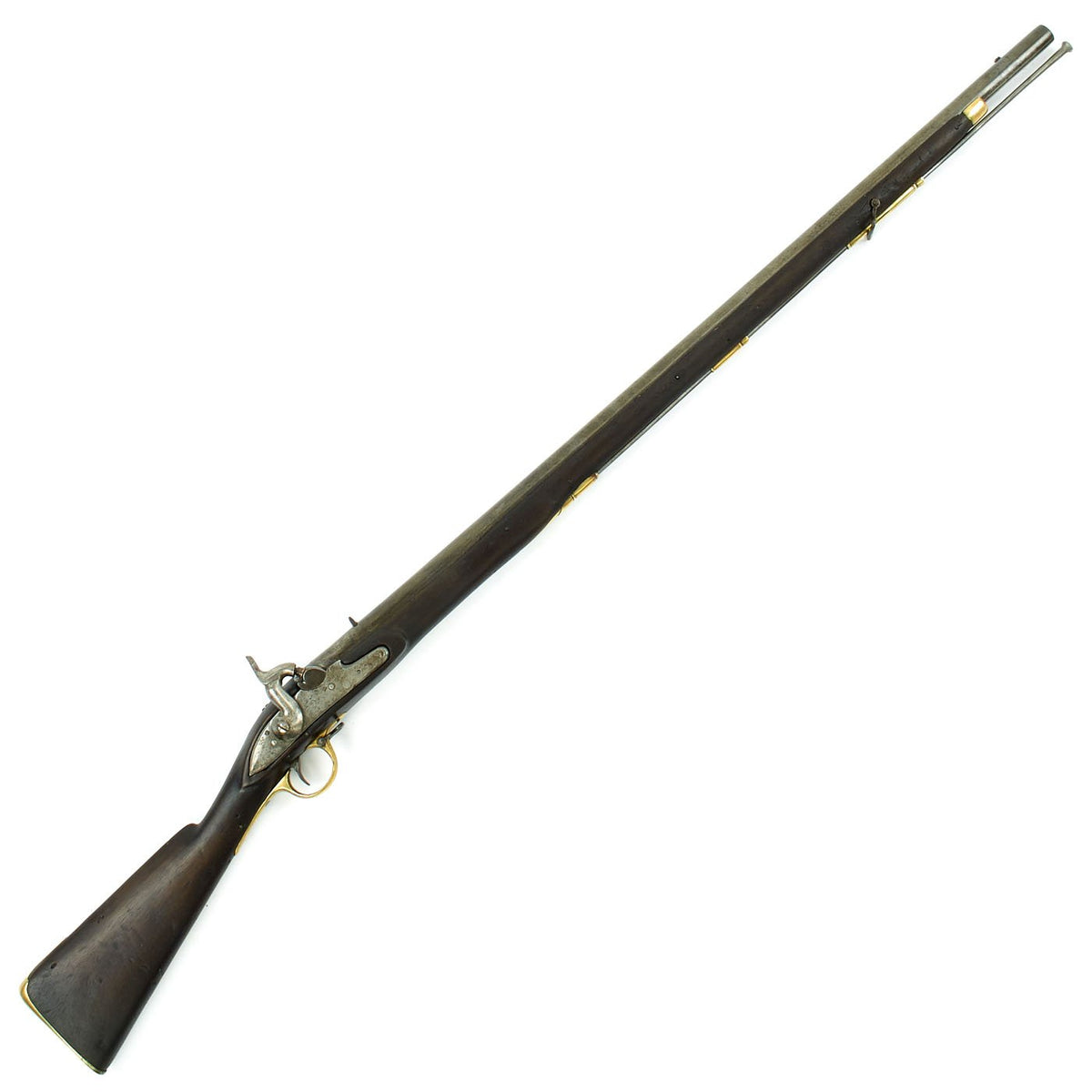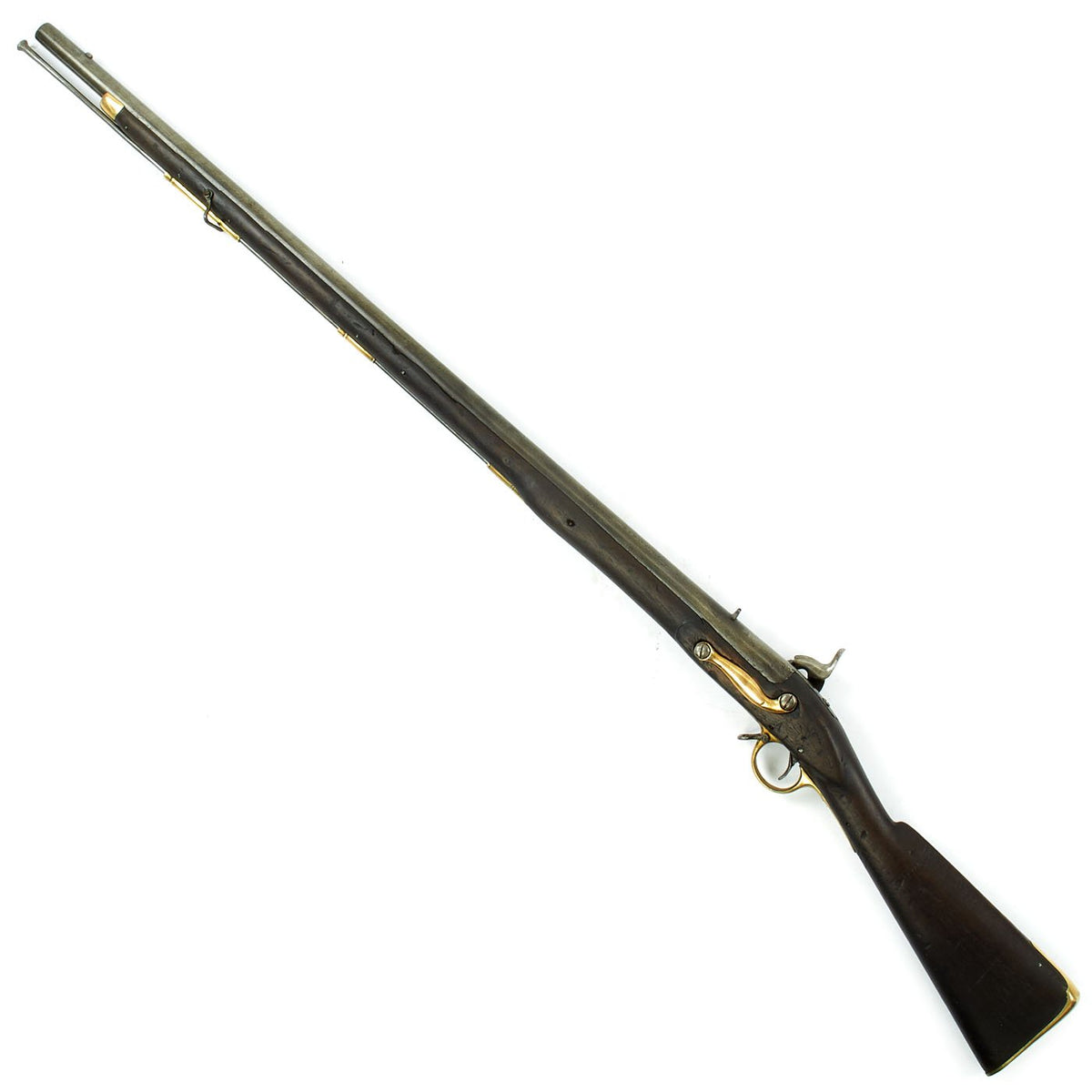Original British East India Company Model A Converted Percussion Musket with Tower Lock – Circa 1835 Original Items
$ 1.495,00 $ 373,75
Original Item: Only One Available: This is a very interesting Musket that started life as a standard 39″ barreled Flintlock Brown Bess most likely of the 1796 India Pattern, as issued to British troops all over the world. The “India Pattern” was based on the “Windus Pattern” used by the East India company since 1771. The lock on this example is marked TOWER across the tail, with CROWN / GR on the lock plate, as well as the lock viewers mark. This definitely began life as a British-Issued military musket.
As the percussion system clearly outperformed the flintlock, in 1839 the Tower of London started a massive Conversion Program to update the National Musket Reserve. However in 1841 a disastrous fire consumed a major portion of the Tower itself and that included over 400,000 converted Flintlock Muskets, putting Great Britain into a serious state of un-readiness. The result was the introduction of the Lovell pattern Percussion Musket of 1842 that was in effect a virtual clone of the then Standard East India Pattern Model E/F Infantry Musket.
What we are offering here is an original Flintlock Brown Bess that was found in Kathmandu, Nepal that had been converted to percussion sometime in the 1830s and issued into East India Company service. This most probably arrived in Nepal with a Sepoy Mutineer after the Great Rebellion on 1857/58 that tore India apart and was only put down with great help provided by Britain’s Nepalese Allies.
A classic musket with standard Brown Bess India Pattern features but converted to percussion, which was thankfully not in the Tower of London at the time of the great fire of 1841.
Fully cleaned and ready to display!
More on the EIC Percussion Muskets:
Official records tell us that the British East India Company procured or made no Flintlock Muskets after the late 1820s and it appears they were very swift to take advantage of the newest in firearms technology- the percussion ignition system. In 1840 the HEIC began producing the world’s very first massed produced percussion muskets one of which later became known as the EIC Model “F”.
A brief history of how this model came to being- The shortened 39″ barrel Brown Bess musket was first developed and adopted by the EIC in 1771. This was a full 25 years before the Board of Ordnance in London followed suit with a 39″ Brown Bess Musket dubbed the “India Pattern” in 1796. This is a testament that private enterprise has seemingly always got things done long before government bureaucrats. In 1839 the British Government officially adopted a converted to percussion Brown Bess musket (P-1796/39) but in the Great Fire of the Tower of London of 1841 over 400,000 of these converted Muskets were destroyed leaving the British Government very short handed. The result, once again, was to copy the current EIC Percussion Musket, the Model “F” and designate it the “Lovell’s Pattern of 1842”. By that time, the EIC had already developed and refined the .75 bore Percussion musket through six models- A to F.
Models A and B were EIC flintlock muskets converted to percussion. However, the Model F was purpose built percussion issue. This Pattern dispensed with the screw on breech (needed because of the unreliability of the brazed on nipple lumps) as improved technology now permitted the welding of the nipple lump directly to the side of the breech. The nipple lump changes shape to fit what was then called the “new style lock”. The lock was of the new percussion type with the mainspring no longer screwed in at its small end but secured under a lip inside the lock plate. The trigger is hung in a box, part of the trigger plate, instead of on a pin in the wood, and the side plate disappeared in favor of the later side nail cups with new Pattern F bayonet catch. These were built or “set up” between 1845 and 1851.
The differences between the various EIC Models are generally minor; Model A and B were Brown Bess flintlock conversions, Model C and D were purpose built percussion muskets but had the “Old Series” side locks with differing trigger guard styles, while the Model E and F both had the “new series” side locks and had either the Hanoverian Catch on the Model E or the EIC bayonet catch on the Model F.
Please See David Harding’s stellar work “Smallarms of the East India Company 1600-1856” published in four volumes by Foresight Books in 1997. Specifically, please see Volume 2, pages 97-124 for a mass of information concerning the vary EIC Model muskets.
Specifications-
Year of Manufacture: circa 1835
Caliber: .75″
Cartridge Type: Ball and Powder
Barrel Length: 39 Inches
Overall Length: 55 Inches
Action type: Side Action Percussion Lock
Feed System: Muzzle Loading
NOTE: International orders of antique firearms MUST be shipped using UPS WW Services (courier). USPS Priority Mail international will not accept these.
Fast Shipping with Professional Packaging
Thanks to our longstanding association with UPS FedEx DHL, and other major international carriers, we are able to provide a range of shipping options. Our warehouse staff is expertly trained and will wrap your products according to our exact and precise specifications. Prior to shipping, your goods will be thoroughly examined and securely secured. We ship to thousands clients each day across multiple countries. This shows how we're dedicated to be the largest retailer on the internet. Warehouses and distribution centres can be located throughout Europe as well as the USA.
Note: Orders with more than one item will be assigned a processing date depending on the item.
Before shipping before shipping, we'll conduct a thorough inspection of the items you have ordered. Today, the majority of orders will be delivered within 48 hours. The delivery time will be between 3-7 days.
Returns
The stock is dynamic and we cannot completely manage it because multiple stakeholders are involved, including our factory and warehouse. So the actual stock may alter at any time. It's possible that you may not receive your order once the order has been made.
Our policy is valid for a period of 30 days. If you don't receive the product within 30 days, we are not able to issue a refund or an exchange.
You can only return an item if it is unused and in the same state as the day you received it. You must have the item in its original packaging.
Related products
Uncategorized
Uncategorized
Uncategorized
Uncategorized
Uncategorized
Australian WWII Owen MK1 Machine Carbine SMG Custom Fabricated Replica with Sling Original Items
Uncategorized
Armoured Fighting Vehicles of the World: AFVs of World War One (Hardcover Book) New Made Items
Uncategorized
Uncategorized
Uncategorized
Uncategorized
Uncategorized
Uncategorized
Angolan Rebel 1970s era 60mm Inert Display Mortar from Angolan Civil War Original Items
Uncategorized
Uncategorized
Uncategorized
Uncategorized












































































